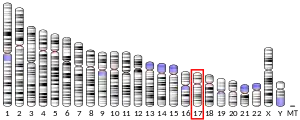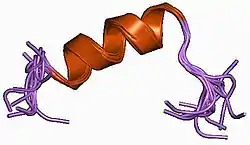| SCN4A | |||||||||||||||||||||||||||||||||||||||||||||||||||
|---|---|---|---|---|---|---|---|---|---|---|---|---|---|---|---|---|---|---|---|---|---|---|---|---|---|---|---|---|---|---|---|---|---|---|---|---|---|---|---|---|---|---|---|---|---|---|---|---|---|---|---|
| Identifiers | |||||||||||||||||||||||||||||||||||||||||||||||||||
| Aliases | SCN4A, CMS16, HOKPP2, HYKPP, HYPP, NAC1A, Na(V)1.4, Nav1.4, SkM1, sodium voltage-gated channel alpha subunit 4 | ||||||||||||||||||||||||||||||||||||||||||||||||||
| External IDs | OMIM: 603967 MGI: 98250 HomoloGene: 283 GeneCards: SCN4A | ||||||||||||||||||||||||||||||||||||||||||||||||||
| |||||||||||||||||||||||||||||||||||||||||||||||||||
| |||||||||||||||||||||||||||||||||||||||||||||||||||
| |||||||||||||||||||||||||||||||||||||||||||||||||||
| |||||||||||||||||||||||||||||||||||||||||||||||||||
| |||||||||||||||||||||||||||||||||||||||||||||||||||
| Wikidata | |||||||||||||||||||||||||||||||||||||||||||||||||||
| |||||||||||||||||||||||||||||||||||||||||||||||||||
Sodium channel protein type 4 subunit alpha is a protein that in humans is encoded by the SCN4A gene.[5][6][7][8]
The Nav1.4 voltage-gated sodium channel is encoded by the SCN4A gene. Mutations in the gene are associated with hypokalemic periodic paralysis, hyperkalemic periodic paralysis, paramyotonia congenita, and potassium-aggravated myotonia.
Function
Voltage-gated sodium channels are transmembrane glycoprotein complexes composed of a large alpha subunit with 24 transmembrane domains and one or more regulatory beta subunits. They are responsible for the generation and propagation of action potentials in neurons and muscle. This gene encodes one member of the sodium channel alpha subunit gene family. It is expressed in skeletal muscle, and mutations in this gene have been linked to several myotonia and periodic paralysis disorders.[8]
Clinical significance
Periodic paralysis
In hypokalemic periodic paralysis, arginine residues making up the voltage sensor of Nav1.4 are mutated. The voltage sensor comprises the S4 alpha helix of each of the four transmembrane domains (I-IV) of the protein, and contains basic residues that only allow entry of the positive sodium ions at appropriate membrane voltages by blocking or opening the channel pore. In patients with these mutations, the channel has a reduced excitability and signals from the central nervous system are unable to depolarise muscle. As a result, the muscle cannot contract efficiently, causing paralysis. The condition is hypokalemic because a low extracellular potassium ion concentration will cause the muscle to repolarise to the resting potential more quickly, so even if calcium conductance does occur it cannot be sustained. It becomes more difficult to reach the calcium threshold at which the muscle can contract, and even if this is reached then the muscle is more likely to relax. Because of this, the severity would be reduced if potassium ion concentrations are kept high.[9][10]
In hyperkalemic periodic paralysis, mutations occur in residues between transmembrane domains III and IV which make up the fast inactivation gate of Nav1.4. Mutations have also been found on the cytoplasmic loops between the S4 and S5 helices of domains II, III and IV, which are the binding sites of the inactivation gate.[11][12]
In patients with these the channel is unable to inactivate, sodium conductance is sustained and the muscle remains permanently tense. Since the motor end plate is depolarized, further signals to contract have no effect (paralysis). The condition is hyperkalemic because a high extracellular potassium ion concentration will make it even more unfavourable for potassium to leave the cell in order to repolarise it to the resting potential, and this further prolongs the sodium conductance and keeps the muscle contracted. Hence, the severity would be reduced if extracellular (serum) potassium ion concentrations are kept low.[10]
Myotonia
The same types of mutations cause myotonia and paralysis, however the difference between these phenotypes depends on the level of sodium current that persists. If the conductance fluctuates below the voltage threshold for Nav1.4, then the sodium channels will eventually be able to close, and be depolarised again. Thus, the muscle merely remains contracted for longer than normal (myotonia) but will relax and be able to contract again within a short period. If the conductance settles at a steady state with the sodium pore open and unable to inactivate, then the muscle is unable to relax at all and motor control is completely lost (paralysis).
References
- 1 2 3 GRCh38: Ensembl release 89: ENSG00000007314 - Ensembl, May 2017
- 1 2 3 GRCm38: Ensembl release 89: ENSMUSG00000001027 - Ensembl, May 2017
- ↑ "Human PubMed Reference:". National Center for Biotechnology Information, U.S. National Library of Medicine.
- ↑ "Mouse PubMed Reference:". National Center for Biotechnology Information, U.S. National Library of Medicine.
- ↑ Ptacek LJ, Trimmer JS, Agnew WS, Roberts JW, Petajan JH, Leppert M (Oct 1991). "Paramyotonia congenita and hyperkalemic periodic paralysis map to the same sodium-channel gene locus". Am J Hum Genet. 49 (4): 851–4. PMC 1683172. PMID 1654742.
- ↑ Ptacek LJ, George AL Jr, Griggs RC, Tawil R, Kallen RG, Barchi RL, Robertson M, Leppert MF (Jan 1992). "Identification of a mutation in the gene causing hyperkalemic periodic paralysis". Cell. 67 (5): 1021–7. doi:10.1016/0092-8674(91)90374-8. PMID 1659948. S2CID 12539865.
- ↑ Catterall WA, Goldin AL, Waxman SG (Dec 2005). "International Union of Pharmacology. XLVII. Nomenclature and structure-function relationships of voltage-gated sodium channels". Pharmacol Rev. 57 (4): 397–409. doi:10.1124/pr.57.4.4. PMID 16382098. S2CID 7332624.
- 1 2 "Entrez Gene: SCN4A sodium channel, voltage-gated, type IV, alpha subunit".
- ↑ Rüdel R, Lehmann-Horn F, Ricker K, Küther G (February 1984). "Hypokalemic periodic paralysis: in vitro investigation of muscle fiber membrane parameters". Muscle & Nerve. 7 (2): 110–20. doi:10.1002/mus.880070205. PMID 6325904. S2CID 25705002.
- 1 2 Jurkat-Rott K, Lehmann-Horn F (August 2005). "Muscle channelopathies and critical points in functional and genetic studies". The Journal of Clinical Investigation. 115 (8): 2000–9. doi:10.1172/JCI25525. PMC 1180551. PMID 16075040.
- ↑ Rojas CV, Wang JZ, Schwartz LS, Hoffman EP, Powell BR, Brown RH (December 1991). "A Met-to-Val mutation in the skeletal muscle Na+ channel α-subunit in hyperkalaemic periodic paralysis". Nature. 354 (6352): 387–9. Bibcode:1991Natur.354..387R. doi:10.1038/354387a0. PMID 1659668. S2CID 4372717.
- ↑ Bendahhou S, Cummins TR, Kula RW, Fu YH, Ptácek LJ (April 2002). "Impairment of slow inactivation as a common mechanism for periodic paralysis in DIIS4-S5". Neurology. 58 (8): 1266–72. doi:10.1212/wnl.58.8.1266. PMID 11971097. S2CID 10412539.
Further reading
- Ackerman MJ, Clapham DE (1997). "Ion channels--basic science and clinical disease". N. Engl. J. Med. 336 (22): 1575–86. doi:10.1056/NEJM199705293362207. PMID 9164815.
- Wang JZ, Rojas CV, Zhou JH, et al. (1992). "Sequence and genomic structure of the human adult skeletal muscle sodium channel alpha subunit gene on 17q". Biochem. Biophys. Res. Commun. 182 (2): 794–801. doi:10.1016/0006-291X(92)91802-W. PMID 1310396.
- Ptacek LJ, Tawil R, Griggs RC, et al. (1992). "Linkage of atypical myotonia congenita to a sodium channel locus". Neurology. 42 (2): 431–3. doi:10.1212/wnl.42.2.431. PMID 1310531. S2CID 12480.
- McClatchey AI, Van den Bergh P, Pericak-Vance MA, et al. (1992). "Temperature-sensitive mutations in the III-IV cytoplasmic loop region of the skeletal muscle sodium channel gene in paramyotonia congenita". Cell. 68 (4): 769–74. doi:10.1016/0092-8674(92)90151-2. PMID 1310898. S2CID 31831830.
- George AL, Komisarof J, Kallen RG, Barchi RL (1992). "Primary structure of the adult human skeletal muscle voltage-dependent sodium channel". Ann. Neurol. 31 (2): 131–7. doi:10.1002/ana.410310203. PMID 1315496. S2CID 37892568.
- Ptácek LJ, George AL, Barchi RL, et al. (1992). "Mutations in an S4 segment of the adult skeletal muscle sodium channel cause paramyotonia congenita". Neuron. 8 (5): 891–7. doi:10.1016/0896-6273(92)90203-P. PMID 1316765. S2CID 41160865.
- McClatchey AI, McKenna-Yasek D, Cros D, et al. (1993). "Novel mutations in families with unusual and variable disorders of the skeletal muscle sodium channel". Nat. Genet. 2 (2): 148–52. doi:10.1038/ng1092-148. PMID 1338909. S2CID 12492661.
- McClatchey AI, Lin CS, Wang J, et al. (1993). "The genomic structure of the human skeletal muscle sodium channel gene". Hum. Mol. Genet. 1 (7): 521–7. doi:10.1093/hmg/1.7.521. PMID 1339144.
- Rojas CV, Wang JZ, Schwartz LS, et al. (1992). "A Met-to-Val mutation in the skeletal muscle Na+ channel alpha-subunit in hyperkalaemic periodic paralysis". Nature. 354 (6352): 387–9. Bibcode:1991Natur.354..387R. doi:10.1038/354387a0. PMID 1659668. S2CID 4372717.
- George AL, Ledbetter DH, Kallen RG, Barchi RL (1991). "Assignment of a human skeletal muscle sodium channel alpha-subunit gene (SCN4A) to 17q23.1-25.3". Genomics. 9 (3): 555–6. doi:10.1016/0888-7543(91)90425-E. PMID 1851726.
- Fontaine B, Khurana TS, Hoffman EP, et al. (1990). "Hyperkalemic periodic paralysis and the adult muscle sodium channel alpha-subunit gene". Science. 250 (4983): 1000–2. Bibcode:1990Sci...250.1000F. doi:10.1126/science.2173143. PMID 2173143.
- Plassart E, Reboul J, Rime CS, et al. (1994). "Mutations in the muscle sodium channel gene (SCN4A) in 13 French families with hyperkalemic periodic paralysis and paramyotonia congenita: phenotype to genotype correlations and demonstration of the predominance of two mutations". Eur. J. Hum. Genet. 2 (2): 110–24. doi:10.1159/000472351. PMID 8044656. S2CID 7672692.
- Ptáĉek LJ, Tawil R, Griggs RC, et al. (1994). "Sodium channel mutations in acetazolamide-responsive myotonia congenita, paramyotonia congenita, and hyperkalemic periodic paralysis". Neurology. 44 (8): 1500–3. doi:10.1212/wnl.44.8.1500. PMID 8058156. S2CID 28470701.
- Heine R, Pika U, Lehmann-Horn F (1993). "A novel SCN4A mutation causing myotonia aggravated by cold and potassium". Hum. Mol. Genet. 2 (9): 1349–53. doi:10.1093/hmg/2.9.1349. PMID 8242056.
- Lerche H, Heine R, Pika U, et al. (1994). "Human sodium channel myotonia: slowed channel inactivation due to substitutions for a glycine within the III-IV linker". J. Physiol. 470: 13–22. doi:10.1113/jphysiol.1993.sp019843. PMC 1143902. PMID 8308722.
- George AL, Iyer GS, Kleinfield R, et al. (1993). "Genomic organization of the human skeletal muscle sodium channel gene". Genomics. 15 (3): 598–606. doi:10.1006/geno.1993.1113. PMID 8385647.
- Ptacek LJ, Gouw L, Kwieciński H, et al. (1993). "Sodium channel mutations in paramyotonia congenita and hyperkalemic periodic paralysis". Ann. Neurol. 33 (3): 300–7. doi:10.1002/ana.410330312. PMID 8388676. S2CID 33366273.
This article incorporates text from the United States National Library of Medicine, which is in the public domain.





